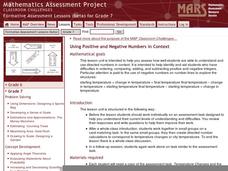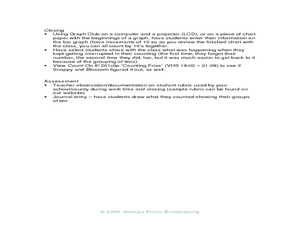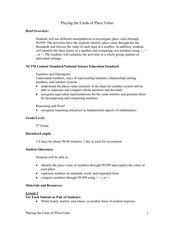Illustrative Mathematics
Teen Go Fish
Kindergartners play the classic game Go Fish as they practice identifying numbers in the teens. A fun and engaging activity that develops number recognition skills in young learners. As added support, provide cards that include both the...
Illustrative Mathematics
Numbers in a Multiplication Table
Identifying patterns is a crucial skill for all mathematicians, young and old. Explore the multiplication table with your class, using patterns and symmetry to teach about square numbers, prime numbers, and the commutative and identity...
EngageNY
Comparing Integers and Other Rational Numbers
The ninth installment of a 21-part module has pupils compare integers and rational numbers in decimal and fraction form. They match stories to number lines and compare values in the stories.
Curated OER
Unit 5: Order Whole Numbers in the 100s and 1,000s
There are three quick number ordering activities here for your mathematicians. First, they analyze data on the number of three types of pies sold. Scholars choose from four ordered lists the one showing fewest to most sold. Then, they...
CK-12 Foundation
Numbers in Expanded Form: Pennies Expanded Form
Beginning with a word problem that poses the question of making groups of 10 pennies to translate into a single dime, pupils are challenged to make sense of the amount of dollars 33 cents is in expanded form.
CK-12 Foundation
Mixed Numbers in Applications: Sharing a Chocolate Bar
The advantage of a virtual chocolate bar: it never melts. Learners use an interactive to share a chocolate bar among friends. Some challenge questions assess understanding of fractions in relation to this context.
American Library Association
Even and Odd Numbers: Lesson Plans and Sample Problems
If your youngsters are new to numbers, here are several interactive strategies to get them thinking about even and odd numbers. For example, they can count the number of desks, people, etc. in the room and determine if it is even or odd....
EngageNY
Ordering Integers and Other Rational Numbers
Scholars learn to order rational numbers in the seventh instructional activity in a series of 21. Reasoning about numbers on a number line allows for this ordering.
Curated OER
Sets Of
Represent multiplication as sets of items for beginners to this concept. They look at six familiar object sets and determine the total number of legs by counting the sets. There is some scaffolding here, as the first is done for them and...
Mathematics Assessment Project
Using Positive and Negative Numbers in Context
Measure the temperature of your math class with a temperature-based lesson on adding and subtracting rational numbers. The thermometer serves as a vertical number line for learners as they work together to solve a temperature change...
Code.org
Encoding Numbers in the Real World
Ah, the numerous number of numbers. Individuals research different ways of encoding numbers. After conducting their initial research, they find classmates who have researched a different article and the pair share information. The lesson...
EngageNY
Even and Odd Numbers
Even or not, here I come. Groups investigate the parity of products and sums of whole numbers in the 17th lesson in a series of 21. Using dots to represent numbers, they develop a pattern for the products of two even numbers; two odd...
Illustrative Mathematics
Money in the Piggy Bank
It's time to crack open that piggy bank and see what's inside. First, count up the pennies, nickels, dimes, and quarters, identifying what fraction of them are dimes. Then calculate the total value of the coins, writing another fraction...
EngageNY
The Opposite of a Number's Opposite
It's said that opposites attract, but what about opposites of opposites? Individuals learn about the opposite of opposites using number lines. They complete a group activity in which members determine the opposite of opposites of integers.
Curated OER
Real Numbers in the Real World
Delve into the concept of operating on the set of real numbers! In this operating with the set of real numbers instructional activity, pupils perform order of operations on the set of real numbers using a calculator.
Curated OER
Place Value of Whole Numbers Through One Million
Third graders construct numbers to the millions place. In this 30-page place value instructional activity, learners create numbers and evaluate the place value of digits. They explore standard and expanded form of numbers. An incredible...
Alabama Learning Exchange
Classifying Complex Numbers
Imaginary numbers are a real thing. Scholars learn about complex numbers, real numbers, and imaginary numbers. They classify given numbers as strictly complex, strictly real, or strictly imaginary in an individual or group activity.
National WWII Museum
The War in Europe: Evaluating Historic Decisions
War brings a whole new set of ethical dilemmas. From deciding whether to enlist in a segregated and racist Army to whether to sacrifice civilian lives to prepare for a critical D-Day invasion, leaders during World War II faced many...
Curated OER
An Easier Way to Count: Using Groups of 10
Students explore their counting skills. In this counting lesson, students group objects in sets of 10 to practice counting them. Students also practice graphing the sets of objects they count. This lesson incorporates the use a video...
Illustrative Mathematics
Assessing Sequencing Numbers
Assess whether your kindergartners can identify numbers in random order using two sets of numeral cards 1-10 and 11-20. Starting with a small group and the 1-10 deck give your learners the task of putting the cards into order from...
Illustrative Mathematics
Assessing Writing Numbers
Can I say a number by its name, and can you write it for me? Working in small groups or with the whole class, give your kindergartners a piece of 1-inch graph paper and have them write numbers 0 to 10 and 11 to 20. Next, pass out blank...
CK-12 Foundation
Values Written as Powers: Binary Numbers 9 to 16
Challenge mathematicians to crack the binary code with an interactive that focuses on numbers nine to 16. A table reveals exponential equations to aid in answering multiple-choice questions. A discussion question gauges comprehension.
EngageNY
Real-World Positive and Negative Numbers and Zero II
Continuing from the previous lesson in the series, scholars learn to use positive and negative integers to describe real-world situations. In groups, they come up with their own situations for given positive and negative integers.
Curated OER
Playing the Cards of Place Value
Third graders explore place value to the ten-thousands place. In this amazing, 21-page place value instructional activity, learners represent numbers in standard and expanded form, and use technology to represent numbers to 9,999.

























